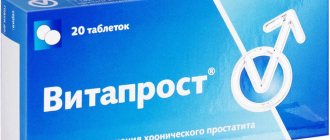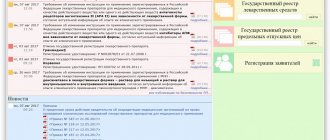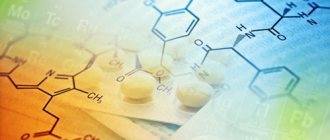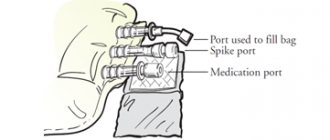Introduction
In accordance with WHO recommendations, national regulatory authorities in the field of medicines circulation in the Russian Federation have in recent years paid special attention to the creation of a system for the rational use of medicines.
The regulatory document of the Ministry of Health of the Russian Federation defines the Strategy for drug provision to the population until 2025, which was approved by Order of the Ministry of Health dated February 13, 2013 No. 66 (as amended on April 7, 2016) “On approval of the Strategy for drug provision to the population of the Russian Federation for the period until 2025 year and the plan for its implementation." One of the key provisions of the rational use system is independent objective professional information about drugs, which is an important factor influencing the competence and awareness of medical personnel. The problem of rational use of drugs includes several areas, including the use of drugs with proven effectiveness and safety and the possibility of preventing unwanted side reactions of drugs [2].
For a number of reasons, specialists in the healthcare system in the Russian Federation often do not have objective and timely professional information about drugs due to the increase in the number of circulating drugs on the pharmaceutical market, the predominance of generic drugs of domestic and imported production and the lack of accessible information databases on their interchangeability with reference drugs [3].
In accordance with federal laws dated April 12, 2010 No. 61-FZ “On the circulation of medicines” and dated December 22, 2014 No. 429-FZ “On amendments to the Federal Law “On the circulation of medicines” in the Russian Federation and introduced new concepts: “reference medicinal product”, “interchangeable medicinal products”. The wording of the concept of “generic medicinal product” was changed and Article 27.1 “Procedure for determining the interchangeability of medicinal products for medical use” was introduced for the first time.
According to a number of studies, the most effective and safe drug among all trade names corresponding to one international nonproprietary name (INN) is the reference drug. However, the use of a reproduced drug instead of a reference drug, even for economic reasons, can be justified only if the specialist is convinced that this will not reduce the effectiveness and safety of pharmacotherapy.
In accordance with the current order of the Ministry of Health of the Russian Federation dated January 14, 2019 No. 4n “On approval of the procedure for prescribing medicines, forms of prescription forms for medicines, the procedure for completing these forms, their recording and storage”, “the prescription of medicines is carried out by a medical worker according to international nonproprietary name (INN), and in its absence - by group or chemical name. In the absence of an INN and a group or chemical name of a medicinal product, the medicinal product is prescribed by a medical professional according to its trade name” [4]. If earlier in the choice of a particular drug the determining role could be played by the loyalty of the attending physician to a particular drug, today this factor is the personal preferences of the buyer, coupled with the recommendations of the pharmacy specialist dispensing the drug.
Prospects for resolving these issues in order to improve the quality of pharmaceutical care are outlined in the order of the Government of the Russian Federation dated January 12, 2018 No. 9-r “Development of competition in healthcare,” which approved an action plan (“road map”). This plan provides for the introduction of a number of changes to the legal regulation relating to the interchangeability of medicines in particular. Among other things, the “road map” provides for ensuring the functioning of the institution of drug interchangeability, including the formation of a list of reference drugs, the formation of a register of standard instructions for the use of interchangeable drugs.
In the Russian Federation, among the official information sources about drugs, the first position is occupied by the online resource “State Register of Medicines” (GRLS) as an independent, accurate, structured, objective and verified source of information. GRLS is a publication of the Russian Ministry of Health, which includes a list of domestic and foreign drugs (medicinal products and pharmaceutical substances) approved for medical use in our country. Each drug registered in the Russian Federation corresponds to a page in the GRLS system.
GRLS contains a list of medicines that have passed state registration, while all medicines are presented with registration certificates consisting of 12 sections, allowing you to obtain the following information:
Registration certificate number, registration date, re-registration date, date of introduction into civil circulation.
Name of the holder or holder of the marketing authorization, indicating the country.
Trade name of the drug.
International nonproprietary, or group, or chemical name.
Release form indicating the dosage form, dosage, expiration date, storage conditions.
Information about the stages of production, including stages of production, address of the manufacturer, manufacturer, country.
Instructions for using the drug via the active “Show instructions” button.
Regulatory documents indicating the number of the regulatory document, year, change number.
Pharmacotherapeutic group.
Anatomical and therapeutic chemical classification indicating the drug code.
Pharmaceutical substance indicating the international nonproprietary, or group, or chemical name, manufacturer, address of the manufacturer.
Special marks include: the presence of drugs in the list of vital and essential drugs; the presence in the medicine of narcotic drugs, psychotropic substances and their precursors, subject to control in the Russian Federation in accordance with the legislation of the Russian Federation, international treaties of the Russian Federation, including the Single Convention on Narcotic Drugs of 1961 and the Convention on Psychotropic Substances of 1971; referentiality and interchangeability of drugs.
The great advantage of using the GRLS resource to obtain information about drugs is that it provides information about registration and re-registration, about manufacturers at all stages of production, information about the pharmaceutical substance and a scanned version of the instructions for use of the drug from the developer. In addition, the resource contains valuable information about the presence of this drug in the list of vital and essential drugs, about the reference drug, the interchangeability of the drug, and the date of re-registration of the drug, which today is not presented in a systematic form anywhere else.
Due to the great significance of the issues identified, the authors conducted a study of the awareness of medical workers in the Irkutsk region on the issues of referenceability and interchangeability of drugs, and also analyzed options for search work in the GRLS system.
About medicines
About medicines
Attention! The trade names of all drugs in this article are provided for illustrative purposes only and are not intended to indicate the benefits of using any particular drug.
About trade and international names of drugs
All drugs presented on the Russian pharmaceutical market have two names - the trade name and the international nonproprietary name (INN). INN denotes the active substance of the drug - the medicinal substance, which provides the necessary therapeutic effect. As the term implies, the INN of a drug will be the same in all countries in which the drug is available. As a rule, the INN is selected based on the chemical name of the active ingredient of the drug.
The manufacturing company may not register an additional trade name of the drug and release it under the INN. In this case, its trade name will coincide with the INN; often, to identify such drugs, the name of the manufacturer is added to the name of the active substance.
In the market, one INN can be represented under many trade names. A trade name denotes a drug that is produced by a specific manufacturer. Let’s assume that your doctor prescribed you the drug Femara® for a diagnosis of breast cancer, but when you came to the pharmacy, the pharmacist told you that Femara® was not available and suggested its analogue, letrozole. In this situation, the pharmacist suggested that you use a drug similar to the one prescribed - containing the same active ingredient - a “generic”.
Doctors often use trade rather than international names of drugs in their speech, without referring to the drug from a specific manufacturer (for example, the trade names “Xeloda” or “Tutabine” instead of the INN capecitabine).
About original drugs and “generics”
Many pharmaceutical companies are developing new drugs. In addition to the development process itself, in order to prove the effectiveness and safety of a new drug, they conduct clinical studies (for more details, see the section “How are clinical studies conducted?”). They take a lot of time and are very expensive. In addition to the direct costs of developing a new molecule and conducting research before the drug enters the market, its price includes the costs of developing all drugs that turned out to be “unsuccessful” and did not pass all stages of clinical trials. A drug developed and brought to market for the first time is called an “originator drug.”
In order to support the development of new drugs that patients need, a system of patent protection for original drugs has been adopted. It implies that the company that was the first to develop and market a new drug receives the exclusive right to produce and sell it for a period of time. The term of such patent protection varies in different countries, for example, in the USA it is 12 years, in Russia it can reach 25 years.
During the period of validity of the patent, only the original drug is available on the market; the manufacturing company, having a monopoly right to its production, strives to recoup its costs for its development and research (as well as for all its drugs that have not reached the market). The consequence of this is the high price of original drugs.
After the patent expires, the company that first developed and launched the drug on the market loses the exclusive right to sell it, and generic drugs or analogues of the original drug may appear on the market. The production of “generics” can be carried out by any pharmaceutical company that has the technologies necessary to synthesize the desired chemical substance. “Generics” undergo a simplified registration procedure - since the main biological effects of the active substance of these drugs are already known, there is no need to conduct large-scale and costly clinical studies.
Most often, “generics” are registered based on the results of clinical bioequivalence studies - small studies, the number of participants, as a rule, does not exceed several dozen. Within the framework of these studies, a comparison is made of the pharmacokinetic properties (characteristics of absorption, distribution of the drug throughout the body, its metabolism and excretion), and not the pharmacodynamic properties (main biological effects) of the original and generic drugs.
What are “generics” needed for?
If it provides data that the drug is similar to the original one, it is registered and can be freely sold on the market, competing with the original drug. As follows from what was written above, the main advantage of “generics” is their relatively low cost - generic drugs can be several times cheaper than the original ones, since their manufacturers incur minimal costs for releasing their drug to the market.
Theoretically, the use of “generics” instead of original drugs is beneficial for both patients and the healthcare system, since the price of a “generic” is always lower than the price of the original drug - why overpay for a “brand”, knowing that the exact same medicine can be bought much cheaper ? In addition, competition and the loss of a monopoly position in the market forces the manufacturer of the original drug to reduce the price.
In practice, however, some nuances arise. From a chemical point of view, the active substance in the drugs is the same. In accordance with the law, the same excipients (“fillers”, additional ingredients such as sucrose, dyes, etc.) must be used.
Possible disadvantages of using generics and briefly about their production
However, some differences are possible, which may result in differences in the effectiveness and safety of original drugs and “generics” associated with their production technology - the same substance can be obtained using different methods of its synthesis and subsequent purification.
In addition, a unique national feature of the pharmaceutical market in the Russian Federation is the virtual lack of control over the quality of drug production. That is, at the stage of bioequivalence studies, the reproduced drug is always of high quality - as otherwise it would be studied. However, in the future, no one can guarantee that the manufactured drug will undergo the necessary purification and be produced properly, using high-quality equipment and in compliance with sanitary and hygienic standards and production process standards. The widespread introduction of production standards can help solve this problem.
Good Manufacturing Practice - GMP (Good Manufacturing Practice) standard
Currently, “generics” are used in clinical practice in all countries of the world, this can significantly save money for the healthcare system and patients. The safety and effectiveness of their use does not raise questions - if they are properly produced.
To ensure high-quality production of medicines, both original and “generic” ones, the so-called. Good Manufacturing Practice (GMP) standards. They regulate the requirements for organizing the production of medicines. In accordance with the principles of GMP, the manufacturer of the drug must produce medicines in such a way as to guarantee their compliance with their intended purpose, the documents that were used when registering the drug, and use only high-quality pharmaceutical substances for the production of medicines. The main purpose of this is to eliminate risks associated with unsatisfactory properties of drugs, their safety, quality or effectiveness. The manufacturer must continuously monitor the quality of drug production processes, ensure the availability of qualified personnel, etc. Unlike random sample checks, GMP principles are aimed at ensuring quality throughout the entire production period of the drug. In Russia, for the production of “generics”, as a rule, ready-made pharmaceutical substances are used, which are the synthesized active ingredient of the drug in large packaging (for example, 1 kg). Most often, these drugs are imported into the Russian Federation from other countries; in Russia, they are packaged in consumer packaging at the final manufacturer’s factories. In order to maintain low prices, companies most often use cheap pharmaceutical substances produced in India or China.
Despite the fact that since 2013 in Russia, Order No. 916 of the Ministry of Industry and Trade of the Russian Federation has been in force “On approval of the Rules for organizing the production and quality control of medicines,” compliance by the manufacturer with these requirements remains at its discretion, and Russian supervisory services (for example, Roszdravnadzor) virtually do not have the ability to control the quality of drugs.
Failure to comply with production standards and GMP standards entails the following main risks:
- Purchase and use of low-quality pharmaceutical substance - the active ingredient of the drug, which may be ineffective or unsafe;
- Storage and transportation of drugs in inappropriate conditions, which may result in the destruction of the active substance of the drug - for example, the often used cytostatic drug 5-fluorouracil is destroyed under the influence of sunlight;
- Bacterial contamination of the drug during the production of the drug and its packaging in the final consumer packaging, destruction of the drug in case of poor-quality packaging;
Why do oncologists use such drugs? Often they have no choice. In accordance with federal legislation, healthcare institutions purchase medicines within the framework of special competitive procedures - tenders. The tender is won by the manufacturer who offered the lowest price for the supply of the medicine, and the presence of a GMP certificate is not taken into account. Companies that produce high-quality medicines incur high costs for their production, and therefore often do not have the opportunity to compete with cheap “Russian-Chinese” medicines. This creates a “vicious circle” in the patient treatment system. The current procurement model incentivizes companies to produce drugs as cheaply as possible rather than better, encouraging unscrupulous companies and depriving consumers of access to quality drugs.
How can I tell if the drug I am being offered is of high quality?
In the Russian Federation there is a special database that contains information about all drugs in circulation on the pharmaceutical market in our country - the State Register of Medicines (GRLS). It is publicly available at . On the same website, the latest versions of instructions on the medical use of drugs are available for review.
It allows you to search for medications by trade name, international name, drug manufacturer, etc. The GRLS interface is shown in Figure 1.
Figure 1. General view of the interface of the State Register of Medicines
As an example, let’s consider one of the most commonly used drugs in oncology practice – paclitaxel. By searching for the INN of a given drug, you can see that there are many trade names represented on the pharmaceutical market of the Russian Federation. Figure 2 shows an example of a search for this drug.
Figure 2. Example of paclitaxel drugs (presented for all names) registered in the Russian Federation. The trade names of the drugs are highlighted in red, the countries in which the manufacturing companies are registered are in green.
It is worth noting that the fact of registration of a manufacturer in any country does not always mean that the drug is completely produced on its territory. As an example, we can take the drug Intaxel produced by Fresenius Kabi (Germany). By opening detailed information on the drug, you can see that the pharmaceutical substance and the drug itself were manufactured in India (this in itself does not mean that the drug is of low quality, see below). A similar situation, as a rule, is observed with drugs produced in Russia.
Using GRLS you can find all generic drugs registered in Russia. How to choose the best one? Having chosen any reproduced drug (“generic”), look for information about the company that produces it, try to find information about whether the manufacturer has a GMP certificate. If a company does not have such a certificate, this is a serious reason to think about whether its products are worth purchasing. The list below shows some companies that manufacture in accordance with GMP standards (the list is not complete):
- TEVA (Teva)
- Actavis/Allergan (Actavis/Allergan)
- Fresenius Kabi
- Sandoz/Ebewe (Sandoz/Ebewe)
- BIOCAD
It should be borne in mind that compliance with the above algorithm does not guarantee the quality of the drugs. Even manufacturers of original drugs are not immune from errors in the production process, although they can significantly reduce its likelihood.
In addition, in the pharmacy chain there are also counterfeit medicines - counterfeits, which may differ significantly in their composition from the drug for which they pretend to be. Taking this into account, if you purchase medications on your own, it is worth doing this in specialized oncology pharmacies, private or public chain pharmacies - in many cases they directly cooperate with manufacturers.
Summary
In the absence of state control over the quality of medicines and the massive entry of cheap drugs of questionable quality into oncology institutions, patient awareness of this problem is critically important. Ask your doctor about which medications you are prescribed and in what dosage. Be sure to check the specific trade name of the drug. If you have doubts that the drug offered to you is of high quality, remember your right to purchase the necessary drugs yourself.
It is not necessary to purchase expensive original drugs. The optimal choice is high-quality “generics” produced by well-known companies that have a GMP certificate. Paying attention to your own health is an important part of successful treatment.
Algorithms for working with GRLS
The authors have developed several algorithms for working with GRLS.
If a doctor needs to obtain information about the reference quality of a particular drug, he can search using the following algorithm:
Log in to the GRLS website https://grls.rosminzdrav.ru.
In the GRLS section “Medicines”, enter the drug’s INN in the search bar. All registered medicines containing medicines under this INN are displayed in the form of a table. If the manufacturer is known, as well as the trade name of a given drug, the search can be narrowed by entering the known information in the appropriate lines.
By selecting the row with the desired drug in the table, the user goes to the registration certificate page. Section 12 “Special notes” displays information about the reference nature of the drug.
As an example, we will obtain information about the reference drug for the drug dutasteride, which is a selective inhibitor of 5-alpha reductase. In the search line in the “State Register of Medicines” section we enter the INN - “dutasteride”, a table appears with the search result, including three drugs. By going to the page of the registration certificate of the first drug (Gardium, Israel), in the “Special notes” section we find information that this drug is not the reference drug, using the active link we go to the page of the registration certificate of the reference drug (Fig. 2).
In the case when a doctor needs to select an interchangeable drug that corresponds to a known reference drug, he can search using the proposed algorithm:
Log in to the GRLS website https://grls.rosminzdrav.ru.
In the GRLS section “Medicines”, enter the trade name of the known reference drug in the search bar. All forms of release of this reference drug are displayed in table form. Having selected the desired line, the user goes to the registration certificate page. Section 12 “Special Notes” displays information about interchangeable medicines in the form of links to the registration certificates of the corresponding medicines.
As an example, we will search for interchangeable drugs for the drug Avodart® (INN dutasteride). In the search bar in the “State Register of Medicines” section, enter the trade name - “Avodart”. In the table with the search result, we select the drug in the dosage form we need - “capsules”. Having opened the registration certificate of this drug, we go to section 12, where the sign of reference is displayed and there are active links to the corresponding interchangeable drugs with an equivalent dosage form and dosage (Fig. 3).
By clicking on the active links, we will find out the trade names of interchangeable drugs - Gardium, Dutasteride Bacter.
It is more difficult to search for a reference drug if only the INN is known. If the drug is not interchangeable, information about the corresponding reference drug is not displayed in section 12. Therefore, the user needs to open the registration certificate pages one by one until the result is obtained. As an example, we will search for a reference drug for the drug candesartan, which is used in the treatment of arterial hypertension. We enter the INN “candesartan” into the search bar, the result is obtained in the form of a table, including 15 registered drugs (including combination drugs). Having selected the first drug Candesartan (), we go to the page of the registration certificate of this drug. At the bottom of the page information about the interchangeability of this drug is displayed, as well as active links to the corresponding reference drug. Registration certificate LSR-001353/08 corresponds to the drug Atakand®.





